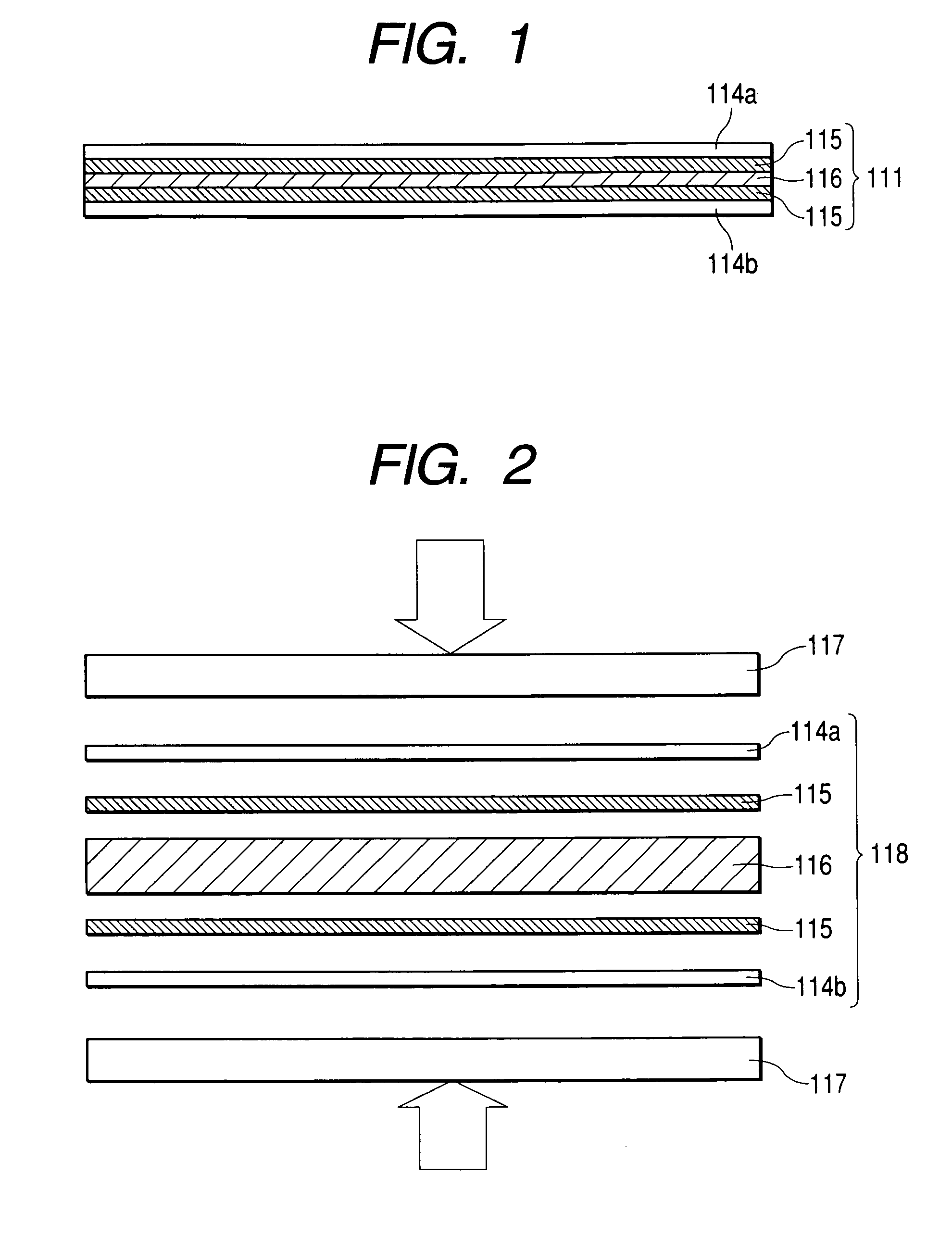Scintillator panel, radiation detecting apparatus, and radiation detection system
a technology of radiation detection apparatus and scintillator, which is applied in the field of scintillator, can solve the problems of deteriorating production efficiency, increasing costs, and taking a long time to form the insulative layer
- Summary
- Abstract
- Description
- Claims
- Application Information
AI Technical Summary
Benefits of technology
Problems solved by technology
Method used
Image
Examples
embodiments
(Embodiments)
[0038]The invention will be described in detail hereinbelow with reference to the drawings.
[0039]FIG. 1 is a cross sectional view showing an embodiment of a supporting substrate in a scintillator panel of the invention. FIG. 2 is a diagram showing a manufacturing method of the supporting substrate in the scintillator panel of the invention.
[0040]Reference numeral 111 denotes a supporting substrate; 114a and 114b moisture-proof metal foils; 115 non-conductive layers; and 116 a rigidity holding layer. In the supporting substrate 111, the rigidity holding layer 116 is sandwiched by the two non-conductive layers 115 and both surfaces of the supporting substrate 111 are substantially non-conductive layers. The rigidity holding layer 116 can be a laminate in a state where it is completely separated like layers or can be also constructed in such a manner that a rigidity holding member exists in the non-conductive layers without a distinct boundary and the rigidity holding laye...
example 1
[0062]As shown in FIG. 6, the photodetecting portions (pixel portions) 102 are formed onto the glass substrate 101 by thin semiconductor films made of amorphous silicon. A first protective layer 105 made of SiNx and, further, a polyimide resin are spin-coated onto them and hardened at 200° C. for 6 hours and a second protective layer 106 is formed, thereby manufacturing the photodetector 100.
[0063]Subsequently, aromatic polyimide precursors having a thickness of 5 μm and serving as non-conductive layers 115 are coated onto both surfaces of an aromatic polyimide resin having a thickness of 0.5 mm and serving as a rigidity holding layer 116. Aluminum foils having a thickness of 20 μm and serving as moisture-proof metal foils 114a and 114b are laminated onto the surfaces of the aromatic polyimide precursors, pressed, and thereafter, pressed with heat at 270° C., thereby molding the supporting member 118. Upon molding of the supporting member 118, the supporting member 118 is molded by ...
example 2
[0067]The photodetector 100 is manufactured in a manner similar to Example 1.
[0068]The phosphor layer 112 of the columnar crystal made of CsI:Tl is formed onto the surface of the moisture-proof metal foil 114b of the molded supporting member 118 in a manner similar to Example 1. After that, the top face and the side surfaces of the phosphor layer 112 and the surfaces and the edge surfaces other than the region where the phosphor layer 112 is formed on the side of the supporting member 118 where the phosphor layer 112 is formed excluding the moisture-proof metal foil 114a on which the phosphor layer 112 is not formed are coated with the moisture resistant protective layer 113 comprising the organic film made of polyparaxylylene by the CVD method, thereby obtaining the scintillator panel 110.
[0069]The obtained scintillator panel 110 is adhered to the photodetector 100 in a manner similar to Example 1, thereby obtaining the radiation detecting apparatus.
[0070]The radiation detecting ap...
PUM
 Login to View More
Login to View More Abstract
Description
Claims
Application Information
 Login to View More
Login to View More - R&D
- Intellectual Property
- Life Sciences
- Materials
- Tech Scout
- Unparalleled Data Quality
- Higher Quality Content
- 60% Fewer Hallucinations
Browse by: Latest US Patents, China's latest patents, Technical Efficacy Thesaurus, Application Domain, Technology Topic, Popular Technical Reports.
© 2025 PatSnap. All rights reserved.Legal|Privacy policy|Modern Slavery Act Transparency Statement|Sitemap|About US| Contact US: help@patsnap.com



